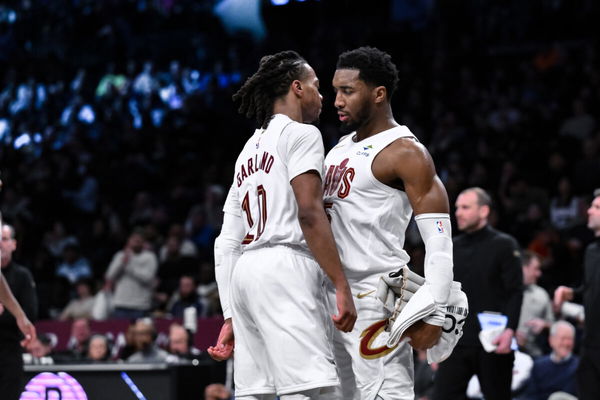
Imago
Apr 20, 2025; Cleveland, Ohio, USA; Cleveland Cavaliers guard Donovan Mitchell (45) walks on the court in the first quarter against the Miami Heat at Rocket Arena. Mandatory Credit: David Richard-Imagn Images

Imago
Apr 20, 2025; Cleveland, Ohio, USA; Cleveland Cavaliers guard Donovan Mitchell (45) walks on the court in the first quarter against the Miami Heat at Rocket Arena. Mandatory Credit: David Richard-Imagn Images
The Cleveland Cavaliers are entering what many believe to be their most important campaign since the 2009–10 season. That was the year LeBron James’ looming free agency put the franchise under a spotlight, ultimately leading to his departure for Miami. With Donovan Mitchell at the helm and the team locked into an expensive, high-stakes roster, the Cavs find themselves in a similar situation: a talented group with expectations of a deep playoff run and tiny margin for error.
Watch What’s Trending Now!
The front office has pushed its chips to the center of the table. Cleveland is one of the few teams in the NBA sitting in the second apron, an unforgiving salary cap threshold restricting trades, sign-and-trades, and roster flexibility. Their ability to pivot is limited, making this season a make-or-break moment. The financial and competitive pressure will undoubtedly trigger a shakeup if this roster doesn’t produce a deep playoff run.
Insider Chris Mannix captured this sentiment succinctly on Sports Illustrated’s ‘Open Floor’: “I think this is the most important Cavs season since the ’09-’10 season. That was the year LeBron was in a contract year… they had to do something. Turns out they didn’t, and LeBron left for Miami.” His words are more than a reflection: they are a warning to a franchise that cannot afford another missed opportunity.
ADVERTISEMENT
Roster-wise, Cleveland had what Mannix called a “quiet” offseason, but not an inactive one. Lonzo Ball arrived to shore up bench playmaking, Tyrese Proctor adds youthful energy and spot-up shooting, and Larry Nance Jr. returns to bring versatility and veteran savvy. Yet departures like Isaac Okoro and Ty Jerome chip away at depth, and the injury to Max Strus, a three-to four-month absence, further complicates spacing and scoring balance heading into the season.
And the path through the East? On paper, it’s clearer than it has been in years. Boston is no longer the powerhouse it was, Indiana is recovering from Tyrese Haliburton’s injury, and Milwaukee is weakened after Damian Lillard’s exit. This is a rare window for Cleveland to capitalize. The conference landscape, once a gauntlet, has softened just as the Cavs reach their most pressure-packed year since LeBron’s first exit.
Every move, or lack thereof, has brought them to this point. The roster is talented but expensive, the stakes are high, and the runway is short. For Donovan Mitchell, who has yet to reach the Conference Finals, the narrative of this season could define his tenure in Cleveland altogether.
ADVERTISEMENT
A season of opportunity or upheaval?
Cleveland’s second apron status cuts both ways. It signals ownership’s commitment to win but slams the door on most forms of roster tinkering. With around $19 million over the second apron, the Cavaliers face restrictions on mid-level exceptions, can’t aggregate salaries easily in trades, and lose the ability to send out cash in deals. Those limitations will define their flexibility until 2026 unless success justifies the cost.
ADVERTISEMENT

Imago
Feb 20, 2025; Brooklyn, New York, USA; Cleveland Cavaliers guards Darius Garland (10) and Donovan Mitchell (45) react during the second half against the Brooklyn Nets at Barclays Center. Mandatory Credit: John Jones-Imagn Images
Mitchell may be the focal point, but he can’t carry this alone. Last playoffs, he averaged 29.6 points and 3.9 assists, but the Cavs’ offensive rating dropped to 114 against the Pacers from their league-leading 121.7 in the regular season. The arrivals of Lonzo Ball and rookie Tyrese Proctor must stabilize that flow, especially with Max Strus sidelined for three to four months after posting 9.4 points per game on 38.6% from deep in 2024–25.
If Cleveland falters, the repercussions could be significant. Mannix didn’t mince words: “Given that they’re in the second apron… we could see this team torn apart.” That might not mean a complete teardown, but moving core pieces is possible. Darius Garland’s $36 million cap hit, Evan Mobley’s looming extension projected around $46 million next year, and Mitchell’s $46 million salary make any failure in 2025–26 a catalyst for drastic cap recalibration.
ADVERTISEMENT
ADVERTISEMENT
ADVERTISEMENT
ADVERTISEMENT

